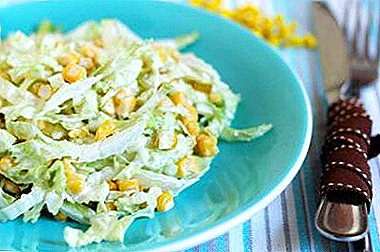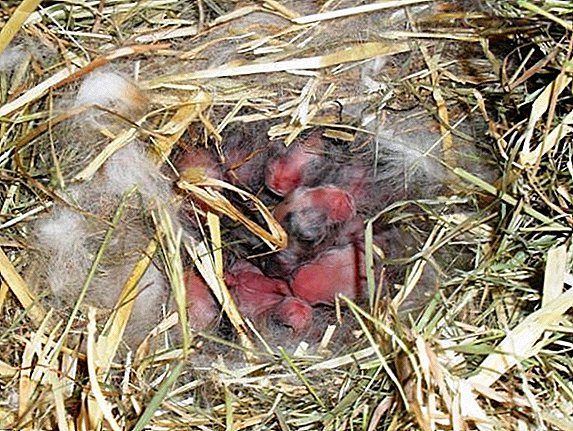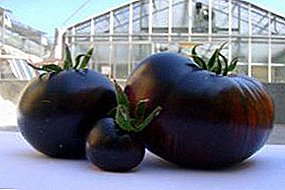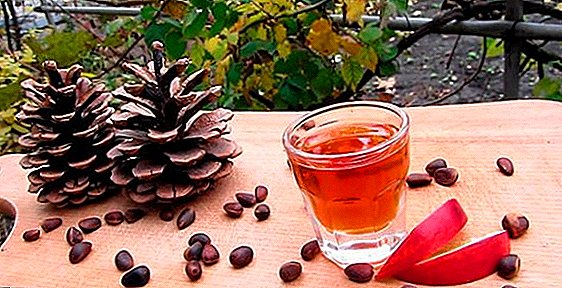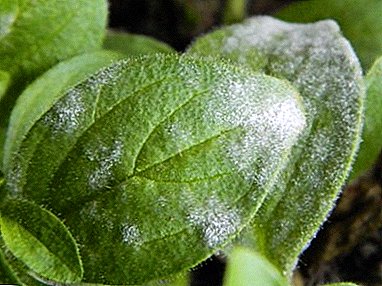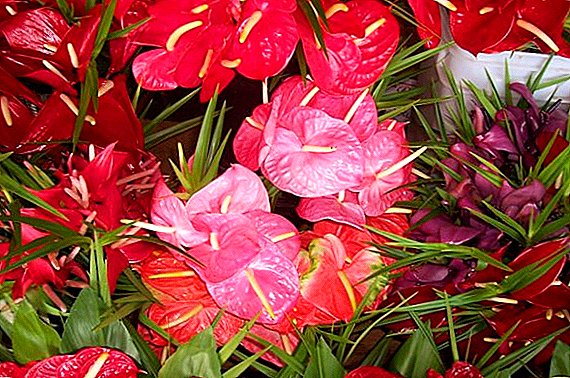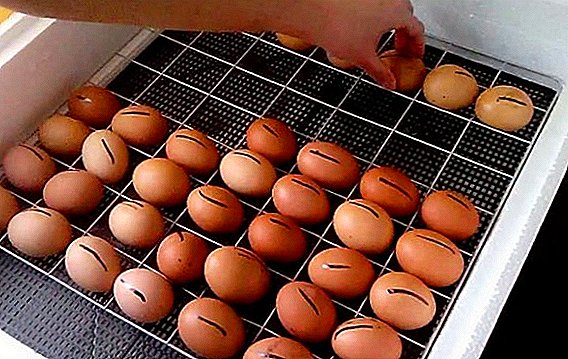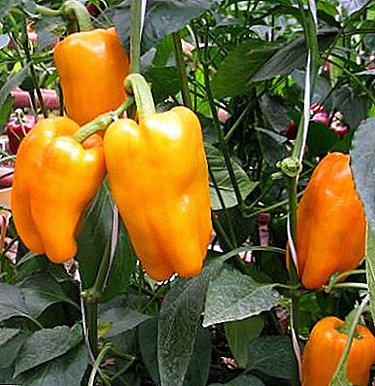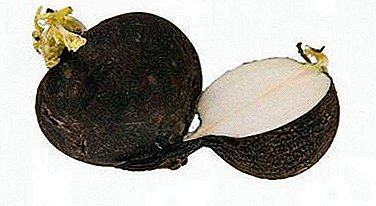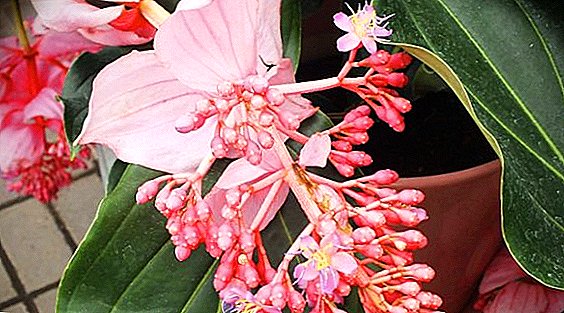 Medinilla is one of the most unusual and expensive plants that can be grown at home.
Medinilla is one of the most unusual and expensive plants that can be grown at home.
The case is not easy, because tropical culture is very capricious. Read about all the nuances of growing medinilla below.
Botanical description of the plant
Medinilla is ranked as the Melastom family. It comes from the tropics of Africa, Asia, and the Pacific Islands. It is a low shrub, tree or creeper with a height of 0.3-2 m. Under natural conditions, a plant can grow from both the ground and other plants.
It has dark green leaves, which are located opposite or sequentially. They can be attached simply to the stalk or grow on the petioles. Depending on the type of edge can be solid or serrated.  Medinignal blossoms in spring with apical or axillary buds in the form of brushes that grow vertically or droop down. They range from 4 to 6 flowers with oval or oblong petals of pink, white, purple, salmon flowers. Under natural conditions, the inflorescences can reach a height of 0.5-1 m. On one bush, 8-10 inflorescences are tied. Flowering lasts 1.5-2 months.
Medinignal blossoms in spring with apical or axillary buds in the form of brushes that grow vertically or droop down. They range from 4 to 6 flowers with oval or oblong petals of pink, white, purple, salmon flowers. Under natural conditions, the inflorescences can reach a height of 0.5-1 m. On one bush, 8-10 inflorescences are tied. Flowering lasts 1.5-2 months.
After pollination, fruit-berries are formed in the form of balls, ovals, jugs, in which seeds are placed with a smooth surface.
Did you know? Medinilla is named after José de Medinilla y Pineda, who in 1820 served as governor of the Mariana Islands, which are located in the Pacific Ocean and belong to the Spanish colonies.
The main types of plants
The genus medinilla has about 200 species. The most famous are:
- Spiny This shrub in nature is half-epiphyte. He has thin shoots in the form of tubules, dark green oval leaves with sharp ends and distinct veins. In length they reach 9–20 cm, 5–9 cm in width. In spring, inflorescences appear in the sinuses in the form of tubules with white or light lilac flowers. This variety is grown in greenhouses.

- Kuminga. This species also leads a semi-epiphytic lifestyle. Its leaves are shiny, oval, slightly concave. Grows in length up to 30 cm, in width - up to 20 cm. Inflorescences in the form of brushes. They are pink flowers.

- Javanica. It is a small shrub with ovoid leaves. He has inflorescences drooping with flowers of purple without bracts.

J'adore Dolce Vita is a hybrid of the magnificent medina. It forms beautiful pink flowers with numerous narrowed bracts.
Did you know? In 2012, experts of the International Union for Conservation of Nature during the study of biodiversity in the Fiji Islands discovered a new species of flower from the genus Mininilla, and in a single copy. He was named after the village near which he was found - Matasavaleva.
Conditions for growing at home
Medinilla, like many tropical cultures, is demanding for growing conditions and high-quality regular care. She is called capricious beauty. If the flower does not create favorite conditions in the form of good lighting, heat, high humidity and lack of drafts, then it will either be ugly or refuse to grow at all.
Location and lighting
For this room culture, bright but diffused light and a long light day are important. In the spring and summer, it should be protected from direct sunlight, growing around the southeast or southwest windows. In the winter, the south side is well suited for it.  Medinilla loves fresh air, so when it is grown in a room, frequent airing is important. But it is necessary to ensure that the plant does not fall under the action of cold air currents. Drafts for the flower are destructive.
Medinilla loves fresh air, so when it is grown in a room, frequent airing is important. But it is necessary to ensure that the plant does not fall under the action of cold air currents. Drafts for the flower are destructive.
Important! When the plant has blossomed flowers, change the location of the pot and even turn it should not be. This will adversely affect flowering - it will shorten its time and lead to a quick drop of flowers.
Air temperature and humidity
The ideal temperature for plant growth is from + 20 ° C to + 25 ° C. At higher temperatures, the flower is uncomfortable. In the heat it must be maintained at high humidity.
In winter, in the dormant period, the plant will be comfortable at lower temperatures, but not lower than + 16 ° С. Lowering the temperature in winter is not necessary, but it has a beneficial effect on the budding of flower buds.  The humidity of the air in the room where the medium grows should be maintained at 75% and above. Such indicators can be achieved by daily spraying the space around the flower with warm, non-rigid water, placing the plant pot on a tray with wet clay, pebbles, and wiping the leaves with a wet cloth. During the heating season, when the air in the apartment is too dry, you will need to install a humidifier.
The humidity of the air in the room where the medium grows should be maintained at 75% and above. Such indicators can be achieved by daily spraying the space around the flower with warm, non-rigid water, placing the plant pot on a tray with wet clay, pebbles, and wiping the leaves with a wet cloth. During the heating season, when the air in the apartment is too dry, you will need to install a humidifier.
Home care
In order to achieve maximum decoration and flowering from the medinilla, it needs to provide regular and high-quality care, which is a special mode of irrigation, fertilizer application, pruning and transplantation.
Watering rules
Abundant and frequent watering is needed for a flower when it comes out of a state of rest and until the beginning of flowering. The soil should be constantly wet, but not waterlogged. When the flowers have blossomed, watering should be reduced. In the summer, they must again be carried out abundantly and often, as the upper soil layer dries out. From mid-autumn to the end of winter, watering should be significantly reduced.  Water for humidification should be used tap water, but passed through a filter that removes chlorine and impurities, or settled for 1-2 days. It should be at room temperature. Watering with cold water causes serious damage to the plant.
Water for humidification should be used tap water, but passed through a filter that removes chlorine and impurities, or settled for 1-2 days. It should be at room temperature. Watering with cold water causes serious damage to the plant.
You can water the medinuilla in the traditional top way or in the pan. When top watering, it is imperative to ensure that the drops do not fall on the stems, leaves and flowers. This leads to the formation of ugly dark spots.
Top dressing
In order for the plant to grow and develop properly, it needs to be fed. Top dressing is made from March to September. The recommended frequency of fertilizer application is every 2 weeks. For medinilla should buy ready-made mineral mixtures, designed for flowering houseplants. Suitable "Kemira Universal", "Darina".
In summer, the plant can also be fed organic. However, not too often and in small quantities. Korovyak better to exclude.
Important! During the rest period (from October to February) fertilizer is prohibited. This causes great damage to the plant, which since spring significantly reduces its decorative effect and does not bloom well.
Pruning
During flowering, you need to timely remove ottsvetye inflorescences. This will provide an incentive for the formation of new flowers, will contribute to a more abundant and prolonged flowering.
Pruning room culture produce when dry last flower stalks. Remove strongly grown shoots. Pruned branches can be used as cuttings for breeding.
Transfer
Before transplanting, which is made in spring, it is necessary to prepare soil and a container for planting. A medinilla has surface roots, so a shallow but wide pot is suitable for it. It should be 4-5 cm larger in diameter than the previous tank.  The soil is picked up light with good air and moisture conductivity. The store sells compositions for epiphytes, orchids (with the addition of peat), which are ideally suited for medintilla.
The soil is picked up light with good air and moisture conductivity. The store sells compositions for epiphytes, orchids (with the addition of peat), which are ideally suited for medintilla.
If there is no possibility to purchase land, it can be mixed with one's own hands from half-ruined sheet soil, moss-sphagnum and fibrous peat in equal quantities. Before planting, such a substrate will need to be disinfected over steam, boiling, watering with potassium permanganate, keeping in an oven or microwave.
The transplant process is as follows:
- The day before transplanting the plant is good to water.
- Remove the bush from the old pot.
- Clean the root system and carefully examine its condition. If necessary, remove damaged roots.
- At the bottom of the pot pour a layer of drainage.
- Sprinkle it with a layer of soil.
- Set the center of the pot flower.
- Evenly distribute the root system.
- Cover the emptiness with soil, leaving 1.5-2 cm from the top of the pot.
- To produce watering.
Rest period
For better flowering in spring, the plant needs to create conditions so that it passes into a dormant period: gradually, starting in October, reduce the number and volume of irrigation to a minimum and lower the temperature in the room. From September, stop feeding. It is advisable to move the pot with a flower in a place where he will have enough light. If the lighting will be scarce, it is necessary to organize additional lighting. 
Breeding
It is possible to propagate a mediangilla in 2 ways: by cutting and by means of seeds. However, it is worth knowing that the reproduction of any of these methods is difficult. Even experienced growers often fail when trying to propagate such a capricious plant.
Cuttings
Cuttings are cut in January - May. Choose the strongest, healthiest, semi-woody shoots. They cut off a plot of 8-12 cm in height with 2-3 internodes. The lower edge is cut at an acute angle, well dried, and then dipped in "Kornevin." To root the roots, they are planted with a sharp end into a sand-peat mixture, and then placed in conditions with high humidity and a temperature of + 25 ... + 30 ° C. After the stalk shoots, it pinch in order to enhance the growth of lateral shoots. A little later, when he is well rooted, he is transplanted to a permanent place. 
Seeds
Majestic mediunilla seeds can be purchased at a specialty store or online. Usually they are sold packaged in 5 pcs.
Sowing is carried out from February to March. Capacity for landing choose long and shallow. It is filled with a mixture of turf and sand. Seeds are placed on the surface of the soil and deepen by 5 mm. Then moistened with a spray bottle and covered with glass or film. Capacity put in a warm place, preferably with underheating.
Find out which flowers are good for growing at home.
The crops are aired every day so that the fungal infection does not develop in the soil. Humidification produced as needed. Sprouts should appear within a month. Then the shelter is removed. When 2 true leaves appear, sprouts swoop down into separate containers with a diameter of 7 cm, filled with a mixture of leafy ground (1 part) and sand (0.5 parts), which they put in conditions of high humidity. They continue to moisturize as soon as the top soil dries out. After the formation of 5-6 leaves and a strong root system, young plants are planted in permanent pots by transfer.
Difficulty growing
Houseplants get sick only if they are poorly cared for, planted in the wrong soil and capacity, or kept in uncomfortable conditions. The fact that the flower is sick or affected by insect parasites can be recognized by changes in its appearance. Every problem has characteristic symptoms. 
Diseases
If the plant is often exposed to bays, then its roots are affected by rot. The plant has become sluggish, sheds leaves, and an unpleasant odor emanates from the soil — the roots are likely to rot. There is an urgent need for a transplant. The flower is removed from the pot, the root condition is examined, diseased roots are cut, the healthy ones are treated with any systemic fungicide, the slices are powdered with crushed coal and dried. After these procedures, the plant is planted in a new pot and soil. The first watering is made not earlier than in 1.5-2 weeks.
Important! If the plant has root rot, then the pot after it can not be reused. It must be disposed of.
In addition to rot, there may be other problems:
- The leaves are small and curl at the ends. The reason is low humidity. It should be increased by the methods described above in the subparagraph "Air temperature and humidity".
- There is a reset sheets. Leaf fall occurs when the plant is exposed to drafts. If the sheets are dry before this, it may be too hot in the room. Drying of the foliage in winter indicates that the flower is cold.
- In the spring there is no bloom. There may be several reasons: insufficient lighting in the winter, when flower buds are laid; long absence of transplants and soil depletion. If the plant does not bloom, it must be transplanted or fertilized, and also placed under bright diffused lighting.
- There were light spots on the foliage. This problem is observed with too intense light. Flower need to priteni from the sun.
- The plant drops buds. Most likely, it is under the influence of drafts or it has been moved to another place. Also, dropping flowers occurs in low light. It is important to protect the indoor culture from drafts and put it in a place with good light.
Pests
Of insects most often medinyla attack mealybug and spider mite.  If a small insect with a size of 0.2-0.5 cm, the body of which is covered with white bloom and hairs, is noticed on the flower, then this is a mealybug. In the course of his harmful life activity, he leaves on the soil and plant secretions of white color that look like pieces of cotton wool. When it settles on a flower, it slows down or stops growth. To cure indoor culture can be treated with garlic infusion, insecticidal means "Intavir", "Fufanon", "Decis".
If a small insect with a size of 0.2-0.5 cm, the body of which is covered with white bloom and hairs, is noticed on the flower, then this is a mealybug. In the course of his harmful life activity, he leaves on the soil and plant secretions of white color that look like pieces of cotton wool. When it settles on a flower, it slows down or stops growth. To cure indoor culture can be treated with garlic infusion, insecticidal means "Intavir", "Fufanon", "Decis".
Read more about how to deal with spider mites.
The spider mite is a small sucking insect of 0.1-0.2 cm in size, which settles on those plants that grow in the heat with dry air. It can be black or red. In the process of life leaves the foliage on the web. The plant reacts to its presence by yellowing and dropping foliage, the appearance of brown spots on the leaves. To cure a flower, it needs to be sprayed with garlic extract, treated with Apollo, Flumaite, Sunmite acaricides.
So, medinilla is a plant that amazes with its unusual beauty. However, in order to make it decorative, you need to spend a lot of effort and time. Beginners in the flower business of growing this flower is likely to be beyond the power. Medinilla can grow only patient and responsible growers.





